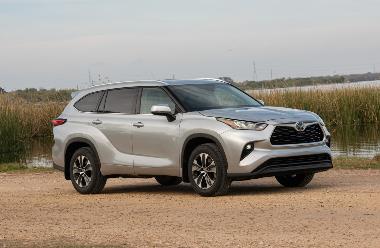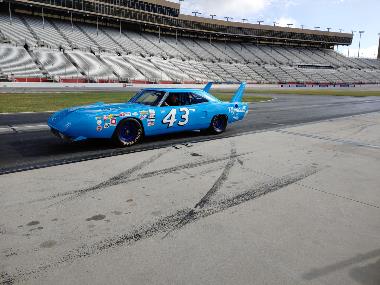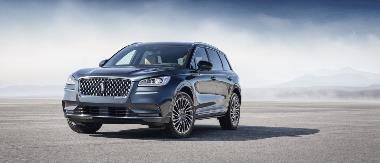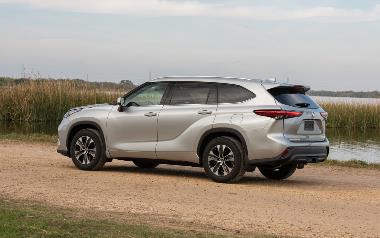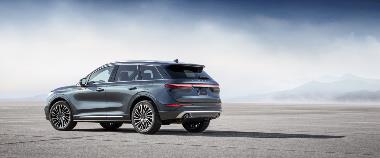The legendary Vought F4U Corsair fighter planes flown by the US Navy and US Marines during WWII and the Korean War, were considered by many to be among the most formidable fighter-bombers in the Pacific, and were flown by Major Gregory “Pappy” Boyington’s "Black Sheep" Squadron. With most Corsairs out of service by 1964, Corsairs flew their final combat missions in 1969 during the “Football War” between Honduras and El Salvador, in service for both air forces.
Fast forward 50 years and change the venue from air to land, and in Lincoln’s new naming strategy, the Corsair Premium Compact Crossover joins the Lincoln Nautilus (previously the MKX), Lincoln Aviator and Lincoln Navigator with sea- or air-oriented monikers -- though a Lincoln press release says Corsair’s name was … “inspired by the Latin word ‘cursus’, meaning journey. Lincoln also markets Corsair as … “the most expressive representation of ‘Quiet Flight’, inviting a more youthful clientele to the brand.” Lincoln’s “Quiet Flight” design treatment features the manufacturer’s new signature grille, full-width taillights and an “S-section” side panel contour. The design accentuates the Corsair’s stance as one of the lowest and widest SUVs in the segment.
Sharing its underpinnings with the all-new 2020 Ford Escape, the Lincoln Corsair replaces the Lincoln MKC in the line-up, and it is packed with standard features including active noise control, AdvanceTrac with Roll Stability Control, Hill Start Assist, Intelligent Access with push-button start, Lincoln Connect with 4G LTE Wi-Fi hotspot powered by Lincoln Way app, remote start, reverse sensing system and lots more.
Corsair’s exterior embraces Lincoln’s “Sculpture in motion” elements of both the full-size Navigator and three-row Aviator, while building on these cues with even more flair. Painstakingly sculpted in clay, Corsair features sophisticated contouring throughout the body section of the door, offering a deep landscape of curvature and relief with a fast-falling roofline.
Enhancing the architecture are body-color, power, heated sideview mirrors with memory and integrated blind spot mirror; LED headlamps with LED signature lamps and autolamp automatic on/off feature; Lincoln Co-Pilot360; and power liftgate.
Available in 10 exterior colors and five interior schemes, the 2020 Corsair measures 180.6 inches long, 76.2 inches wide and 64.1 inches high, on a 106.7-inch wheelbase. Curbweight for my AWD 2.3-liter Reserve trim was 3848 lbs.
The Corsair cabin is quiet, comfortable and filled with conveniences including 10-way power seats that are heated in the front row, with power lumbar and a driver’s side memory feature. There’s also power steering, power windows with one-touch up/down and SYNC® 3 with an 8-inch LCD capacitive touch screen.
Quietness is paramount for Corsair. To ensure a hushed ride, a dual-wall dashboard in the engine compartment provides an additional barrier between passengers and the engine, as an air gap acts to keep vibrations out of the cabin. Active Noise Control enhances overall sound quality throughout, and the quiet is only broken by six unique symphonic chimes – replacing standard electronic alerts to inform drivers of everything from an open fuel door to an unbuckled seat belt.
Roomy inside, you get 39.5 inches of front headroom and 38.7 inches in the rear seats, 43.2 inches of front legroom with 38.6 inches in the second seats, and 57.1 inches of row one shoulder room with 50.8 inches in row two.
From a safety perspective, Corsair is outfitted with a Personal Safety System for driver and front passenger with dual-stage front airbags; driver’s knee, glove box-door-integrated knee, front-seat side, and Safety Canopy System with side-curtain airbags and rollover sensor.
Powerwise, Corsair offers two engine choices … a turbocharged 2.0-liter inline-four that produces 250hp and 280 lb-ft of torque, or a 2.3-liter turbo I-4 that delivers 295 horses and 310 lb-ft. Both are mated to an 8-speed SelectShift Automatic transmission and while the smaller engine is available in FWD and AWD configurations, the 2.3 is primed for AWD only. The 2.0-liter engine is rated at 21mpg/city, 29mpg/highway and 25mpg/combined, while the 2.3-turbo gets 21/city, 28/highway and 24/combined. My week of testing with the larger engine averaged 24.7mpg.
My test Corsair was quicker than expected, steered more carlike than SUV-like, and leveled out road imperfections well enough for the niche. My 2.3-turbo felt faster than the stopwatch indicated, but we still managed a good-for-the-niche 6.2-second hand-timed zero-to-60mph sprint and a 14.8-second hand-timed quarter-mile.
The standard 2020 Lincoln Corsair starts at $35,945 for the 2.0-liter engine, and the Corsair Reserve starts at $42,630 for the 2.0 and FWD. My test Corsair Reserve upgraded to the 2.3-liter turbo and base-priced at $51,010 for AWD and a slew of augmentations including the Reserve I equipment package (Ventilated Front Seats, Heated Second Row Outboard Seats, Heated Steering Wheel, Rain Sensing Wipers, Windshield Wiper De-Icer, Adaptive Cruise Control with Traffic Jam Assist – Includes Lane Centering, Speed Sign Recognition, and Stop-and-Go, 360-Degree Camera with Front Camera Washer, Front Sensing System, Evasive Steering Assist, Reverse Brake Assist and Active Park Assist Plus). In Flight Blue for an extra $695, my Corsair played off a Beyond Blue leather interior for an extra $500. With Destination Charges of $995, an Acquisition Fee of $645 and some manufacturer equipment bundle discounts, my test 2020 Lincoln Corsair Reserve stickered at $52,205.
> Visit www.CarlisleEvents.com for more on the automotive hobby.
Mike Blake, former editor of KIT CAR magazine, joined Carlisle Events as senior automotive journalist in 2004. He's been a "car guy" since the 1960s and has been writing professionally for about 30 years. </I>
.tmb-thumb380.jpg?sfvrsn=ff138f72_0)
